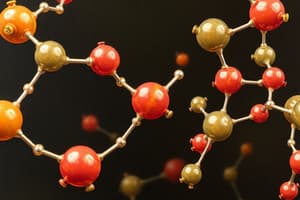Podcast
Questions and Answers
What is a monomer?
What is a monomer?
A monomer is a chemical subunit (the beads of the chain).
What is a polymer?
What is a polymer?
A polymer is a large molecule consisting of long chains of similar subunits.
How do polymers form?
How do polymers form?
Polymers form by dehydration synthesis.
How are polymers broken down?
How are polymers broken down?
What is an enzyme?
What is an enzyme?
What are the four classes of molecules?
What are the four classes of molecules?
Which class is technically not a macromolecule or a polymer?
Which class is technically not a macromolecule or a polymer?
What are some key differences between a saturated fat and an unsaturated fat?
What are some key differences between a saturated fat and an unsaturated fat?
What are the four levels of protein structure?
What are the four levels of protein structure?
What types of bonds/interactions are important at the secondary and tertiary levels of protein structure?
What types of bonds/interactions are important at the secondary and tertiary levels of protein structure?
What are chaperonines?
What are chaperonines?
Why is it crucial that proteins fold the correct way?
Why is it crucial that proteins fold the correct way?
What is the process of protein unfolding called?
What is the process of protein unfolding called?
What can cause a protein to unfold?
What can cause a protein to unfold?
What is the 'backbone' of nucleic acids?
What is the 'backbone' of nucleic acids?
How do DNA and RNA differ?
How do DNA and RNA differ?
What are key characteristics of DNA's structure?
What are key characteristics of DNA's structure?
What is Chargaff's rule?
What is Chargaff's rule?
What is the difference between a pyrimidine base and a purine base?
What is the difference between a pyrimidine base and a purine base?
Which bases are purines and which are pyrimidines?
Which bases are purines and which are pyrimidines?
Flashcards are hidden until you start studying
Study Notes
Monomers and Polymers
- A monomer is a chemical subunit that serves as a building block for larger molecules.
- A polymer consists of long chains of similar monomer subunits, creating large molecules.
Polymer Formation and Breakdown
- Polymers form through dehydration synthesis, a reaction that removes water to connect monomers.
- Polymers are broken down by hydrolysis, which involves adding water to break chemical bonds.
Enzymes
- Enzymes are specialized macromolecules that accelerate chemical reactions in biological processes.
Classes of Biological Molecules
- The four major classes of biological molecules are carbohydrates, proteins, lipids, and nucleic acids.
- Each class has distinct properties and functions, linked by their respective monomers and polymers.
Lipids
- Lipids are unique as they are not classified as macromolecules or polymers.
Fats: Saturated vs Unsaturated
- Saturated fats contain only single bonds between carbon atoms and are solid at room temperature.
- Unsaturated fats have at least one double bond and are usually liquid at room temperature.
Protein Structure
- Proteins have four structural levels: primary, secondary, tertiary, and quaternary.
- Essential components include an amino group, carboxyl group, hydrogen atom, and "R" group.
Protein Interactions
- At the secondary and tertiary levels, hydrogen bonds and interactions between "R" groups are critical for maintaining structure.
Chaperonines
- Chaperonines are proteins that assist in the correct folding of other proteins, protecting them from harmful conditions.
Importance of Proper Folding
- Proper protein folding is crucial as misfolded proteins can lead to diseases.
Protein Denaturation
- The process of protein unfolding is called denaturation; factors include inappropriate pH levels and extreme temperatures.
Nucleic Acids Structure
- The backbone of nucleic acids consists of sugar and phosphate molecules linked together.
Differences Between DNA and RNA
- RNA has ribose sugar, whereas DNA has deoxyribose sugar.
- RNA nucleotides include uracil instead of thymine as found in DNA.
DNA Characteristics
- DNA typically has a double helix structure stabilized by base pairing.
- Bases pair as A-T and G-C, crucial for genetic information storage.
Chargaff's Rule
- Chargaff's rule states that in DNA, there is a 1:1 ratio of pyrimidine to purine bases in any organism.
Base Structures
- Pyrimidine bases are characterized by a single ring structure, while purine bases have a double ring structure.
- Purines include adenine (A) and guanine (G), while pyrimidines include cytosine (C) and thymine (T).
Studying That Suits You
Use AI to generate personalized quizzes and flashcards to suit your learning preferences.



